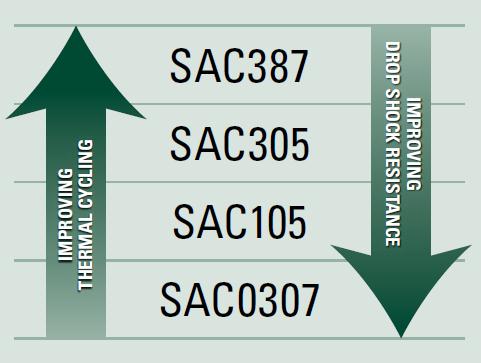As the world began transitioning to Pb-Free solder in the early 2000’s, the electronics industry determined that SAC387 (95.5Sn/3.8Ag/0.7Cu) was the most appropriate alloy to replace eutectic SnPb. While it did have a higher melting point than eutectic SnPb, SAC387 was seen as the best option relative to solderability and usability. The industry quickly shifted to SAC305 (96.5Sn/3.0Ag/0.5Cu) because its lower Ag content resulted in a lower price.
At that time, the industry didn’t realize the performance impact of the Ag content. We now know much more. Ag has a significant impact on a solder alloy's reliability. When thermal cycling higher Ag content SAC alloys (3-4% Ag), the performance tends to be quite good (Ag adds creep resistance to the alloy). However, because of the alloy's rigidity (more Ag - more rigid), it is more prone to brittle fractures during mechanical shock. We achieved significantly improved mechanical shock resistance at the expense of sacrificed thermal cycling performance. The diagram depicts the balance between mechanical shock resistance and thermal cycling performance.
Over the past several years, the Indium Corporation has developed an alloy that minimizes this SAC solder alloy composition compromise. SACm® is a low-Ag alloy that is doped with Mn. This not only improves the mechanical shock resistance over other low-Ag alloys, it also enhances the thermal cycling performance, making it comparable to SAC305. For more information about SACm®, check out our website at www.indium.com/SACm.
*This post is part of the Introducing SACm® series.



